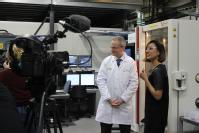WMG News
Fully Charged for Christmas
 Battery experts at WMG, University of Warwick have helped The One Show test AA batteries to determine which last the longest.
Battery experts at WMG, University of Warwick have helped The One Show test AA batteries to determine which last the longest.
More used to testing batteries for transport, including cars, trains and motorsport as it’s Christmas experts were more than happy to help reporter, Anita Rani with a scientific test to understand how a range of different AA batteries available on the high street might perform. The tests were carried out in WMG’s Energy Innovation Centre using the battery characterisation laboratory and part of the £13m Battery Materials Scale-Up Pilot Line.
Mark Amor-Segan, Principal Engineer and Shane Beattie, Technical Manager, for the Battery Scale-up Facility, conducted blind scientific tests on 16 different AA batteries. The batteries came from three different battery chemistry families: i) zinc-chloride, ii) alkaline and iii) lithium. All 16 batteries were tested at a constant current of 500 mA down to 1.1 V. The voltage profile was recorded using a highly accurate battery cycler. All batteries were kept at 20 degrees using a thermal chamber to provide a controlled test environment. For The One Show viewers Anita came armed with 16 toy puppies and fitted each with the 16 different types of batteries. Keeping the puppies in a 20 degree room, the same temperature used to test the batteries, and watched over by a researcher, they were set off to see which would last the longest.
The scientific results correlated with The One Show's puppy test. The worst performing battery for longevity was zinc-chloride and the longest lasting was lithium. However, once you add in the cost of run time/p, the alkaline out performs the others.”
Shane comments:
The test results were interesting and it shows that it is the chemical recipe within a battery that determines the life it has, as well as what item it is being used in. If you want a torch or small toy to last a reasonable amount of time, then an alkaline battery is the best for the job based on cost, with an average run time of 80 minutes at 500 mA and a price as low as 15 p/cell. However if you are using a camcorder or digital camera and don’t want to run out of battery, then a lithium battery is the best choice, and will last up to 350 minutes at 500 mA.”
Notes to Editors
WMG was founded by Professor Lord Bhattacharyya in 1980 to help reinvigorate UK manufacturing. From its inception our mission has been to improve the competitiveness of organisations through the application of value adding innovation, new technologies and skills deployment, bringing academic rigour to industrial and organisational practice.
Today we are one of the world’s leading research and education groups, with over 450 people working across six buildings on the Warwick campus plus collaborative centres in seven countries. We have an annual programme of £180m which includes industrial and in-kind support.
The Energy Innovation Centre includes a £13m Battery Materials Scale-Up Pilot Line, which provides a one-stop-shop for the development of new battery chemistries from concept to fully proven traction batteries, available in sufficient quantities for industrial scale testing. The Centre also includes a battery characterisation laboratory, aggressive testing chambers and an electric/hybrid drives test facility.

